| ¡@J-PARC News - November 2012 (Issue #92) |
| The 1st J-PARC Colloquium was held at the Ibaraki Quantum Beam Research Center on November 20, 2012. The lecture concerned experiments looking for new particles such as the Higgs boson, which is thought to impart mass to all particles, at the European Organization for Nuclear Research (CERN). The invited speaker was Dr. Guido Tonelli (Professor, University of Pisa, Italy), previously the leader of CERN's CMS (Compact Muon Solenoid) Experiment team, which includes many researchers from Europe and the US. He gave an extremely interesting talk on the background of the discovery of the Higgs boson, the only elementary particle predicted by the Standard Model of particle physics which had yet to be found; new scientific progress due to the discovery of the Higgs boson, such as elucidation of the origin of mass and the mystery of the creation of the universe; and expectations for new physics going beyond the Standard Model. The CMS Experiment is a high-energy frontier experiment being carried out by two international research groups at the Large Hadron Collider (LCH) straddling the border between Switzerland and France. On July 4, 2012, CERN announced that the existence of a particle believed to be the Higgs boson was observed in these two experiments, CMS and ATLAS (A Troidal LHC Apparatus). |
 |
 * Click here to enlarge. * Click here to enlarge. |
|
| Attainment of the World's Strongest Pulsed Muon Beam |
| At present, an ultra-slow muon beam line (U-Line) is being constructed in the Muon Science Establishment (MUSE) at the Materials and Life Science Experimental Facility (MLF) of J-PARC. On November 7, the world's highest muon intensity per pulse was attained in this U-line. The observed intensity corresponds to 20 times the previous intensity record, attained in December 2009 on the slow/fast muon beam line (D-line) of the same facility. This result was made possible by success in configuring the U-line using only axial focusing electromagnets such as superconducting solenoid magnets, capturing the muons produced at the muon target with high-efficiency, and transporting them to the experimental apparatus. These electromagnets were developed by the J-PARC/MUSE Group (supervised by Yasuhiro Miyake, Muon Section Leader and Professor, KEK Institute of Materials Structure Science) with the cooperation of the Cryogenic Section. Going forward, these pulsed muons with the world's highest intensity will be made ultra-slow, and it is expected that an "ultra-slow muon microscope" will be realized, and there will be major progress in basic physics research. (Nov. 26 press release) Please see the KEK home page linked below for detailed articles and press releases on the ultra-slow muon microscope.http://www.kek.jp/ja/NewsRoom/Highlights/20120920170000/http://www.kek.jp/ja/NewsRoom/Release/20121126140000/http://legacy.kek.jp/intra-e/press/2012/112714/ (English language site for reference) |
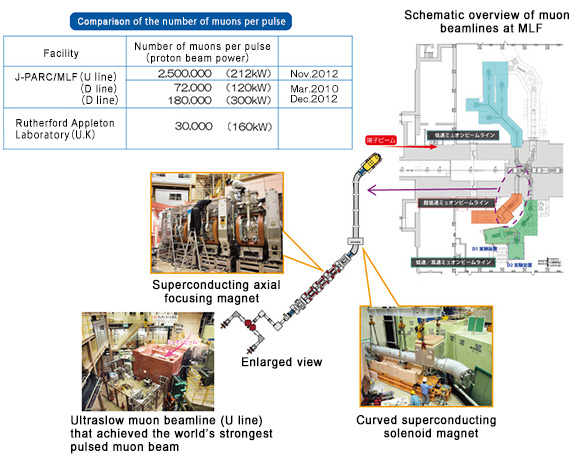
 * Click here to enlarge. * Click here to enlarge. |
| £to Page Top |
|
| Achievement of Neutron Source with World Class Performance at the MLF of J-PARC |
| Various beam studies are being conducted at accelerators in order to achieve high-output operation in the future, and on November 18, a 25 Hz/530 kW proton beam was injected into the Materials and Life Science Experimental Facility (MLF). Reducing the shock waves at beam injection, which cause pitting damage on the inner surface of the mercury target vessel, is a major issue for achieving stable, high-intensity operation in the MLF. Based on previous theory and experimental research, it is expected that providing tiny helium gas bubbles into the mercury will be effective for greatly attenuating the shock waves. The R&D for accepting high-intensity beams has continued since the discovery of pitting damages in 2000 at JAERI. During this summer shutdown, the new target vessel with built-in bubble injector was installed. Following test using 270 kW beam in October 2012, high-power beams of 430 kW and 530 kW were injected in November and vibration intensity of the target vessel, which most likely correlated with the occurrence of pitting damage, was monitored. It was demonstrated that injection of bubbles was effective for greatly reducing the vibration intensity and persistence time. Due to these results, user operation at 270 kW was started in the end of November. MLF became a neutron source with world-class performance in terms of neutron flux per pulse. |
 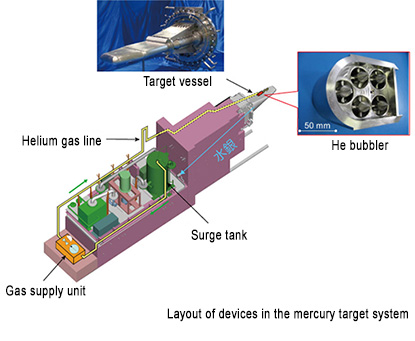 |
 * Click here to enlarge. * Click here to enlarge. |
 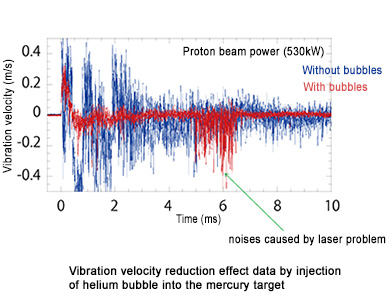 |
 * Click here to enlarge. * Click here to enlarge. |
| £to Page Top |
|
| Update Status of Experimental Facilities |
| At J-PARC, supply of proton beams to experimental facilities for the operation cycle RUN #44 finished on the morning of the 12th, and tasks such as device studies and adjustment have been carried out at each facility before starting RUN #45 on the 21st. The tasks includes studies of devices installed during summer shutdown at the 3 GeV synchrotron, bubbling test operation of the mercury target at the Materials and Life Science Experimental Facility (MLF) (Please read the article in this news letter), and construction of the U-Line at the Muon Experiment Facility in the MLF No. 2 Experiment Hall. Work to switch the secondary particle generation target from platinum to gold was been carried out and construction of the KOTO experiment apparatus is progressing at the neutral kaon (KL) beamline at the Hadron Experimental Facility.
At the Neutrino Experimental Facility, data was steadily collected during RUN #44 for the Tokai to Kamioka Long-Baseline Neutrino Oscillation Experiment (T2K) using a beam intensity of about 200 kW, and this experiment is continuing in RUN #45. |
 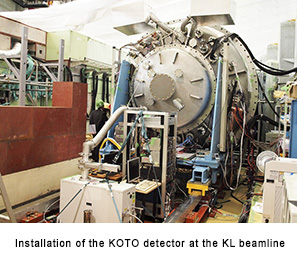 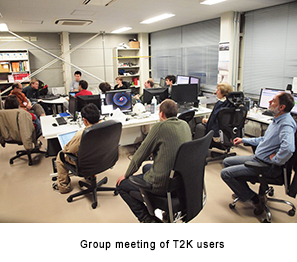 |
 * Click here to enlarge. * Click here to enlarge. * Click here to enlarge. * Click here to enlarge. |
| £to Page Top |
|
| 2012 Ibaraki Prefecture Awards Ceremony on November 13 |
| Shoji Nagamiya, a former Director of the J-PARC Center (currently an advisor) received a Distinguished Service Award in recognition of his valuable efforts in directing the design and construction of J-PARC, the most powerful facility of its kind in the world, and for his contributions to promoting science and technology in Ibaraki Prefecture. The ceremony was held in the auditorium of the Ibaraki Prefectural Government Building on November 13 (Ibaraki Prefecture Day), and 33 individuals and 12 groups received awards for their major contributions to the development of Ibaraki Prefecture. |
 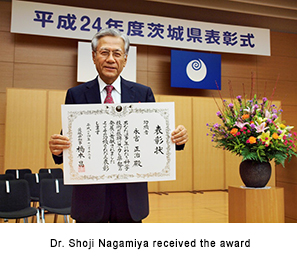 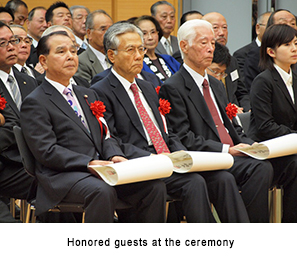 |
 * Click here to enlarge. * Click here to enlarge. * Click here to enlarge. * Click here to enlarge. |
| £to Page Top |
|
| IUCrHP2012/QuBS2012 International Conference on September 23-27 |
| A joint conference organized by the Japan Atomic Energy Agency (JAEA) was held in Mito City, incorporating both the International Union of Crystallography (IUCr) Commission on High Pressure Workshop "Advanced in Crystallography at High Pressures" and the International Symposium of the Quantum Beam Science Directorate, JAEA. There were 95 participants (34 from outside Japan). The program included a keynote lecture, introductions to the directorate and project, 25 invited talks, 11 general talks, and 44 posters. There were conference sessions in 10 fields (phase transitions, liquid/amorphous phases, magnetic/electronic states, organic/biological matter, water/ice, materials science, chemistry, geosciences/planetary sciences, theory/computation, and high-pressure technology) and participants announced their latest results and engaged in lively discussions in a wide range of fields relating to high pressure. In the session on high-pressure technology on the 26th, Dr. Takanori Hattori of the Neutron Science Section of J-PARC reported on the current state of a newhigh-pressure neutron diffractometer (PLANET), which has been constructed in the MLF at J-PARC, and provided an overview of results during its commissioning since October. In the afternoon, participants toured J-PARC, and closely looked at PLANET. |
  |
 * Click here to enlarge. * Click here to enlarge. |
 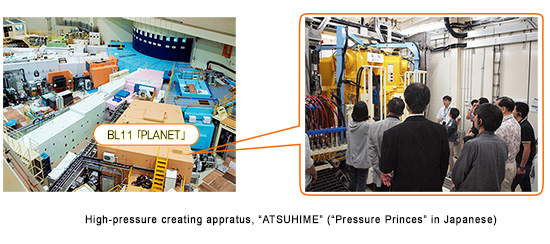 |
 * Click here to enlarge. * Click here to enlarge. |
| £to Page Top |
|
Copyright 2011 JAEA and KEK Joint Project. All rights reserved.
|
|